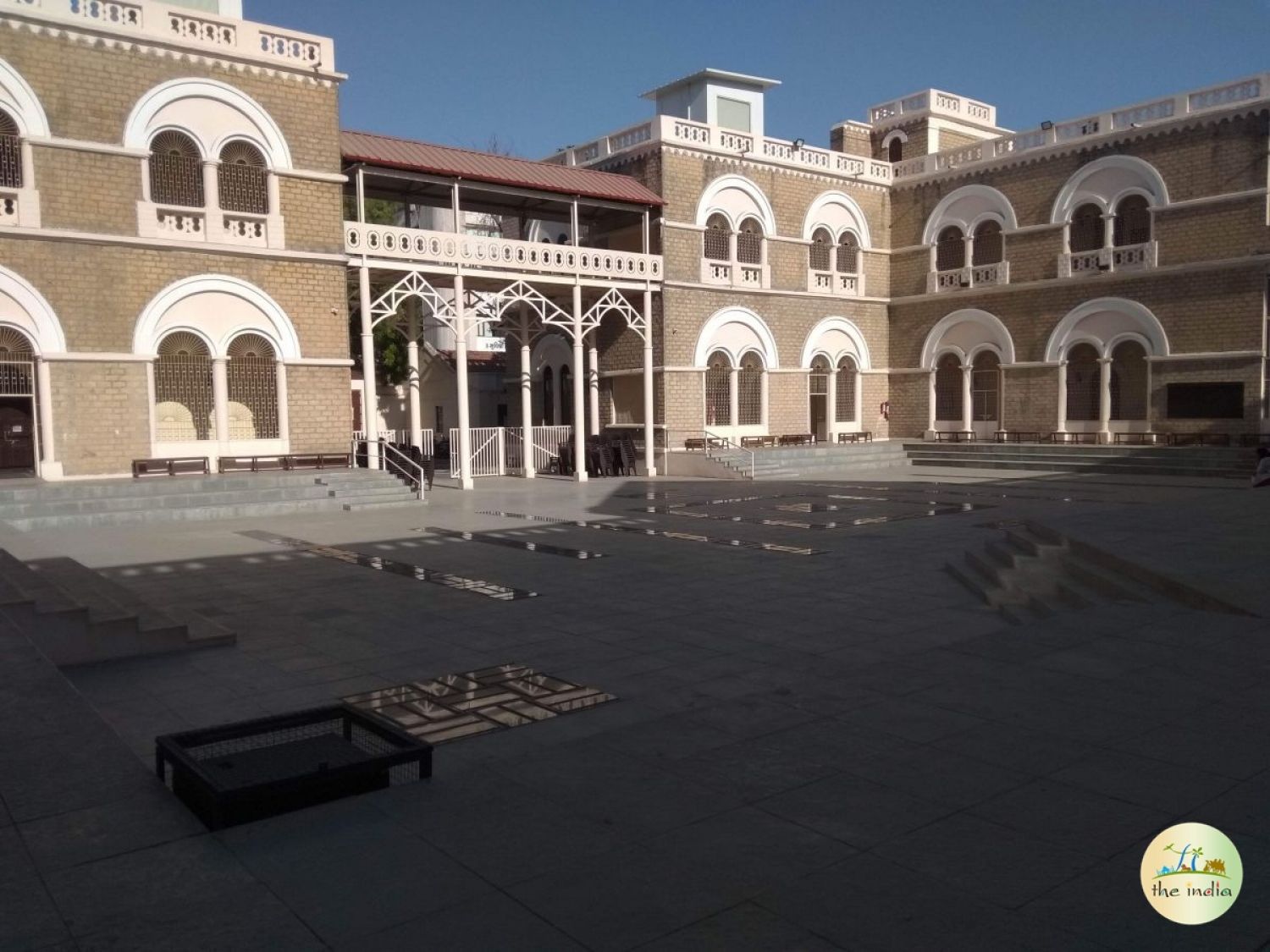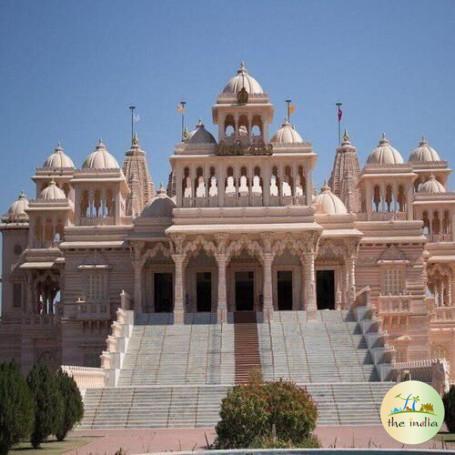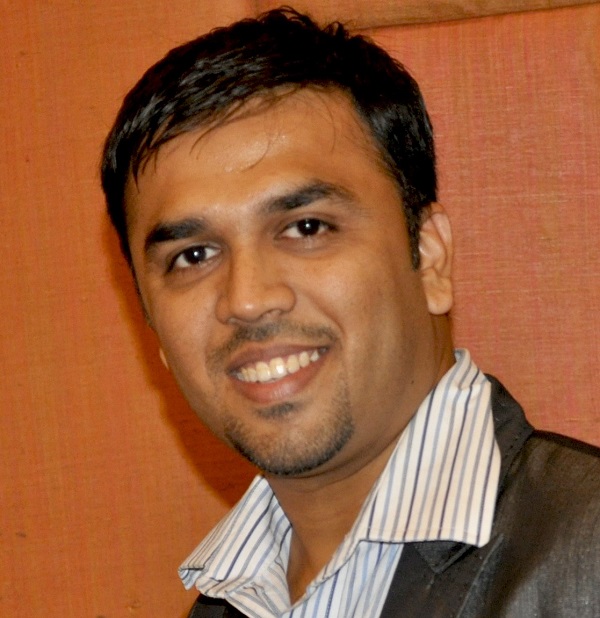The Mahatma Gandhi Museum in Rajkot is a beautiful place to connect with our history. See Gandhi’s memories, learn about his life, and feel proud of India’s past.

Published: byMayank Batavia,25 Mar, 2020
The first thing that strikes you as you enter the parking lot of Mahatma Gandhi Museum, Rajkot is the vast silence surrounding you. It's the silence of a sanctorum santorum in a less-visited pilgrimage - warm and welcoming but encouraging introspection.
It's quite unlikely that you'll be able to rush straight towards the ticket-counter from the parking lot: you ™ll most likely stand there and have a very good look at the beautiful structure before you. Tall, very well built and tastefully restored, the building exudes the majestic charm that many castles and forts do.
But it's hugely different too.
Old castles stand as a testimony of the bravery of kings and battles they had won. This building is an elegant evidence of how one man's commitment to truth and non-violence brought the greatest empire of its time on its knees.
I walk towards the ticket-counter of the Mahatma Gandhi Museum on a warm April afternoon. The entire premises sits huddled amidst trees (and there are many manicured plants and shrubs within the compound) but it's difficult to find stray leaves on the ground, much less dirt or a hint of garbage. Bapu would have loved this, I tell myself.
There 's a middle-aged couple ahead of me at the ticket-counter and they are as pleased as I am with the cleanliness; we agree the cleanliness makes things look more cheerful. One of the three girls behind me, fidgeting with an SLR camera that appears to be newly-bought, nods in approval and turns back to her friends. A man, probably a school-teacher, walking away from the ticket-counter to join a group of young boys instructs them not to litter.
Before entering, I once again stop to admire the exteriors, now from close quarters. I am no architect, but I ™m impressed with the restoration efforts. The facade stones are almost shining, without losing their old-time character; the colors on the arches are subtle and old-world. The stones on the steps are polished and clearly modern, but they blend nicely with the building rather than stand out like a sore thumb.
For those who aren't aware, Mahatma Gandhi Museum is the school-turned-museum located in Rajkot. It was here that the Mahatma - then just a shy, diffident Mohandas Karamchand - studied.
Built from the funds of the then Nawab of Junagadh sometime in the middle of the 19th century, this school was originally known as Rajkot High School and Kathiawar High School (geographically, Kathiawar is the south-western region of Gujarat, covering cities like Junagadh, Rajkot, Morbi, Jamnagar and so on). At the beginning of the 20th century, it was christened Alfred High School a few years after the death of Prince Alfred, the second son of Queen Victoria. Soon after Independence, it was named Mahatma Gandhi High School, though some locals still know it by the name of Alfred High School.
The classrooms of the entire school have been converted into display galleries, numbered 1 through 39. Apart from countless, rare photographs, portraits, recordings, letters, statues of various sizes, there are a number of touch-screen enabled audio-visual presentations and short films that you can watch; there 's even a section where you can put on headphones to hear the recording of Mahatma's voice too.
I enter the building and I'm in a hall.
At the end of the hall is a statue of the Mahatma, in a prayer pose, sitting cross legged with eyes shut. About ten or so kids sit on the ground facing him, in a similar pose. There are a few rows of empty chairs behind the students for visitors willing to join the prayer. As I walk a little closer, I realize the ˜kids' are statues too. All the same, the atmosphere is serene and it's difficult not to sit on the chair and join the ˜prayer' for a few minutes.
After a few minutes, I move to what are Galleries 1 and 2, which, in detail, lay out the early life of Mohandas Gandhi, including his marriage and the passing away of his father. The representation of the home where he was born in Porbandar is particularly endearing and it made me wonder whether anyone present at the house then had any idea what a historical moment that was.
Or whether anyone sitting on the floor, next to Mohan in the classroom knew they were sitting beside the future Father of the Nation.
The next pair of galleries end with an incident etched in every Indian's mind - barrister Mohandas Gandhi being pushed out of the first-class compartment in a train at Pietermaritzburg, South Africa because he was a colored man. It 's a short clipping but electric enough for one of the fellow-visitors (from the bunch of students that had been instructed not to litter) to exclaim something like, œJoje gora, aa bhai taari haalat bagadi nakhshe! (Watch out, white man, this guy is going to make it tough for you!)
As I move into the lobby to enter the next gallery, I can ™t help looking at the ground that the museum encloses. This must have served as an assembly ground when the school was functional (the school ceased to be operational around 2016 or 2017 to begin the restoration work).
The emptiness of the ground, the hush-hush tones in which visitors talk, the measured speech the assistants in each gallery use to explain all exhibits and the warm afternoon further intensifies both the expanse and the silence echoing across the ground.
Gallery 7, I feel, showcases a noticeable turning point in his life when Mohandas begins evolving into a leader of the masses. It has documents and digital displays showing the ˜birth ™ of Satyagraha and the man behind Satyagraha ultimately being jailed in South Africa. Gallery 8 is about the beginning of an active public life of Mr Gandhi upon his return to India.
There 's a small framed collage in Gallery 9 (or was it 10?), one that is very easy to miss. Taking a very minimalist approach, it traces the inner journey of this man.
When he arrived in South Africa, he dressed like the other ˜educated ™ Indians: in a formal western suit. By the time he was fully involved in the struggle there, he had switched to an Indian dress of indentured laborers. When he began touring India, he donned a simple kurta and dhoti, with a Kathiawari pagadi (turban). His transformation reached its pinnacle when he switched his dress for the last time: a short loin cloth and a piece of unstitched cloth for the upper body. He wore the same dress, unapologetically, even when he met the royalty at Buckingham Palace many years later.
I realized the significance of the collage only when a lady pointed out, almost under her breath, that it powerfully captured his transformation from a barrister to a leader to a freedom fighter and finally a man driven by compassion and spiritual values.
I find strong support of the lady 's observation in a photograph in Gallery 10 that would be enough to convey what Gandhi was changing into - a man not just fighting for political independence but also for the rights of the labor class.
This frail looking man showed what massive force his fast-until-settlement commanded, in support of the textile-mill laborers and later during the Quit India movement.
Galleries 15 through 18 shows the ultimate influence and impact of Gandhi - now a Mahatma, no less - over the socio-political canvas of undivided India and beyond. Photographs and exhibits showing him in Aga Khan where Kasturba passed away are particularly poignant.
And then comes the end of the great life, showing India 's independence, his pain of partition and finally his passing away.
Galleries 19 through 29 all talk about the core principles Gandhiji lived by and reminded the world about. They are not merely exhibits but a strong reference base for the entire humanity to live by.
Galleries 30 through 39 deal with Gandhian literature, his inspirations, his original letters and so on, culminating with a synopsis of his relevance in the troubled times we see today.
I look at my watch and realize that I have been here for nearly three-and-a-half hours, and even then I had to skip many exhibits because there were places that were unusually crowded.
As you walk out of the museum, you invariably feel both an awe for the man and the need of such a giant in all ages.
At the exit near the souvenir shop, I casually ask one of the museum assistants how many visitors does the Mahatma Gandhi Museum attract. The number he estimates are modest.
It is close to sundown time and within a couple of hours, the skies will darken and I leave with a strong feeling that we all need light and that more of us should begin experimenting with truth.
Mahatma Gandhi Museum stands in the heart of the city of Rajkot: about 3 kms each from the Railway Station and the Airport and about 1 km from the State Transport Bus Depot.
Visiting hours are 1000 to 1700 hours. The Light and Sound Show runs from 1900 to 1920 hours - it 's good too. The entry ticket is INR 25 for Indian adults; there 's no separate ticket for the Light and Sound Show. Paris 's Louvre Museum tickets cost 17 Euros (roughly INR 1,400), and while there 's no intention to compare the two, the ticket prices of the Mahatma Gandhi Museum might as well be the least expensive in the world for a setup so well-maintained and so enormously important.
There 's a small souvenir shop (been there, worth checking out) and a food court (haven ™t been there) within the premises.
The Mahatma Gandhi Museum remains closed on Mondays. While it 's never extremely crowded, I ™d suggest you visit it just after lunch, say at 1300 hours. If you intend to carefully read stuff and observe things and take notes, you ™ll need at least four hours. Even a rushed visit will need about ninety minutes.
Right across the road behind the museum is another historical complex that houses the Lang Library (now named Arvindbhai Maniyar Pustakalay) and the Watson Museum.
One of the four most important cities of Gujarat, Rajkot is home to over 2 million people and an important commercial location. There 's a fully functional airport, an extremely busy railway station and an equally busy bus depot.
There are a huge number of hotels in all categories; most major restaurant chains have a presence in Rajkot too. Public transportation through the buses managed by the municipal corporation is strong and safe; auto-rickshaws are a great alternative too. Cabs are non-existent, unless you ™ve hired one from your hotel, and they too are used mostly for inter-city travel rather than for the local transportation.
Weather is dry and pleasant for most part of the year. However, if you have lived in cold climates for a long time, you ™ll want to be careful during summers - temperatures can quickly ascend to 44 degrees Celsius (that 's about 111 degrees Fahrenheit).
The local language is Gujarati, but everybody understands Hindi and many business establishments will be able to converse in at least working English.
Credit and debit cards are widely accepted, even at mid-sized businesses.
If you ™re a foodie, Kathiawadi thaali (lunch/dinner) faafda ganthiya, local ice-creams, gola (crushed-ice balls dipped in sweet, syrupy liquids) and peda are the five things to die for in Rajkot. As a matter of fact, locals are rather proud of these items. It 's a dry city in a dry state and alcoholic beverages are available to customers carrying permits only and that too in very few hotels. Non-vegetarian food isn ™t widely available, but that shouldn ™t be a bother; the Kathiawadi thaali is always finger lickin ™ good.
In case you ™re thinking about it, the Mahatma 's birth place Porbandar is about 180 kms from Rajkot.
Photographs by Mayank Batavia for TheIndia.
Customize your dream vacation with our best India tour packages.


0(No Review)
9D/8N
Exciting Gujarat Tour Packages from Ahmedabad (8 Nights-9 Days)
![]() Gujarat, India
Gujarat, India
₹ 35,000


I really enjoyed the way you take me through this Mahatma gandhi museum in Rajkot. Actually, I used to visit Rajkot many times but now, I will definitely give it a visit during my next trip to Rajkot. Thank you

nice

Glad you liked this, Jignesh Gohel! Yes, it sure is an amazing place, a must-visit visiting Rajkot or interested in Gandhiji's life!